Target Information
| Target General Information | Top | |||||
|---|---|---|---|---|---|---|
| Target ID |
T62548
(Former ID: TTDR00280)
|
|||||
| Target Name |
Beta-adrenergic receptor kinase 1 (ADRBK1)
|
|||||
| Synonyms |
GRK2; G-protein coupled receptor kinase 2; BetaARK1; Beta-ARK-1; Beta ARK1
Click to Show/Hide
|
|||||
| Gene Name |
GRK2
|
|||||
| Target Type |
Patented-recorded target
|
[1] | ||||
| Function |
Specifically phosphorylates the agonist-occupied form of the beta-adrenergic and closely related receptors, probably inducing a desensitization of them. Key regulator of LPAR1 signaling. Competes with RALA for binding to LPAR1 thus affecting the signaling properties of the receptor. Desensitizes LPAR1 and LPAR2 in a phosphorylation-independent manner.
Click to Show/Hide
|
|||||
| BioChemical Class |
Kinase
|
|||||
| UniProt ID | ||||||
| EC Number |
EC 2.7.11.15
|
|||||
| Sequence |
MADLEAVLADVSYLMAMEKSKATPAARASKKILLPEPSIRSVMQKYLEDRGEVTFEKIFS
QKLGYLLFRDFCLNHLEEARPLVEFYEEIKKYEKLETEEERVARSREIFDSYIMKELLAC SHPFSKSATEHVQGHLGKKQVPPDLFQPYIEEICQNLRGDVFQKFIESDKFTRFCQWKNV ELNIHLTMNDFSVHRIIGRGGFGEVYGCRKADTGKMYAMKCLDKKRIKMKQGETLALNER IMLSLVSTGDCPFIVCMSYAFHTPDKLSFILDLMNGGDLHYHLSQHGVFSEADMRFYAAE IILGLEHMHNRFVVYRDLKPANILLDEHGHVRISDLGLACDFSKKKPHASVGTHGYMAPE VLQKGVAYDSSADWFSLGCMLFKLLRGHSPFRQHKTKDKHEIDRMTLTMAVELPDSFSPE LRSLLEGLLQRDVNRRLGCLGRGAQEVKESPFFRSLDWQMVFLQKYPPPLIPPRGEVNAA DAFDIGSFDEEDTKGIKLLDSDQELYRNFPLTISERWQQEVAETVFDTINAETDRLEARK KAKNKQLGHEEDYALGKDCIMHGYMSKMGNPFLTQWQRRYFYLFPNRLEWRGEGEAPQSL LTMEEIQSVEETQIKERKCLLLKIRGGKQFILQCDSDPELVQWKKELRDAYREAQQLVQR VPKMKNKPRSPVVELSKVPLVQRGSANGL Click to Show/Hide
|
|||||
| 3D Structure | Click to Show 3D Structure of This Target | PDB | ||||
| HIT2.0 ID | T36O3K | |||||
| Cell-based Target Expression Variations | Top | |||||
|---|---|---|---|---|---|---|
| Cell-based Target Expression Variations | ||||||
| Drug Binding Sites of Target | Top | |||||
|---|---|---|---|---|---|---|
| Ligand Name: Paroxetine | Ligand Info | |||||
| Structure Description | Human G Protein-Coupled Receptor Kinase 2 in Complex with Soluble Gbetagamma Subunits and Paroxetine | PDB:3V5W | ||||
| Method | X-ray diffraction | Resolution | 2.07 Å | Mutation | Yes | [6] |
| PDB Sequence |
KKILLPEPSI
39 RSVMQKYLED49 RGEVTFEKIF59 SQKLGYLLFR69 DFCLNHLEEA79 RPLVEFYEEI 89 KKYEKLETEE99 ERVARSREIF109 DSYIMKELLA119 CSHPFSKSAT129 EHVQGHLGKK 139 QVPPDLFQPY149 IEEICQNLRG159 DVFQKFIESD169 KFTRFCQWKN179 VELNIHLTMN 189 DFSVHRIIGR199 GGFGEVYGCR209 KADTGKMYAM219 KCLDKKRIKM229 KQGETLALNE 239 RIMLSLVSTG249 DCPFIVCMSY259 AFHTPDKLSF269 ILDLMNGGDL279 HYHLSQHGVF 289 SEADMRFYAA299 EIILGLEHMH309 NRFVVYRDLK319 PANILLDEHG329 HVRISDLGLA 339 CDFSKKKPHA349 SVGTHGYMAP359 EVLQKGVAYD369 SSADWFSLGC379 MLFKLLRGHS 389 PFRQHKTKDK399 HEIDRMTLTM409 AVELPDSFSP419 ELRSLLEGLL429 QRDVNRRLGC 439 LGRGAQEVKE449 SPFFRSLDWQ459 MVFLQKYPPP469 LIPPRGEVNA479 ADAFDKGIKL 498 LDSDQELYRN508 FPLTISERWQ518 QEVAETVFDT528 INAETDRLEA538 RKKAKNKQLG 548 HEEDYALGKD558 CIMHGYMSKM568 WQRRYFYLFP585 NRLEWRGEGE595 APQSLLTMEE 605 IQSVEETQIK615 ERKCLLLKIR625 GGKQFILQCD635 SDPELVQWKK645 ELRDAYREAQ 655 QLVQRVPKMK665 NKP
|
|||||
|
|
ILE197
3.513
GLY198
3.727
ARG199
3.305
GLY200
3.439
GLY201
4.937
PHE202
4.470
GLY203
3.314
GLU204
3.976
VAL205
3.436
ALA218
3.252
LYS220
3.801
LEU222
3.197
VAL255
3.439
|
|||||
| Ligand Name: Balanol | Ligand Info | |||||
| Structure Description | Human GRK2 in complex with Gbetgamma subunits and balanol (soak) | PDB:3KRW | ||||
| Method | X-ray diffraction | Resolution | 2.90 Å | Mutation | No | [7] |
| PDB Sequence |
KKILLPEPSI
39 RSVMQKYLED49 RGEVTFEKIF59 SQKLGYLLFR69 DFCLNHLEEA79 RPLVEFYEEI 89 KKYEKLETEE99 ERVARSREIF109 DSYIMKELLA119 HPFSKSATEH131 VQGHLGKKQV 141 PPDLFQPYIE151 EICQNLRGDV161 FQKFIESDKF171 TRFCQWKNVE181 LNIHLTMNDF 191 SVHRIIGRGG201 FGEVYGCRKA211 DTGKMYAMKC221 LDKKRIKMKQ231 GETLALNERI 241 MLSLVSTGDC251 PFIVCMSYAF261 HTPDKLSFIL271 DLMNGGDLHY281 HLSQHGVFSE 291 ADMRFYAAEI301 ILGLEHMHNR311 FVVYRDLKPA321 NILLDEHGHV331 RISDLGLACD 341 FSKKKPHASV351 GTHGYMAPEV361 LQKGVAYDSS371 ADWFSLGCML381 FKLLRGHSPF 391 RQHKTKDKHE401 IDRMTLTMAV411 ELPDSFSPEL421 RSLLEGLLQR431 DVNRRLGCLG 441 RGAQEVKESP451 FFRSLDWQMV461 FLQKYPPPLI471 PPREEDTKGI496 KLLDSDQELY 506 RNFPLTISER516 WQQEVAETVF526 DTINAETDRL536 EARKKAKNKQ546 LGHEEDYALG 556 KDCIMHGYMS566 KMWQRRYFYL583 FPNRLEWRGE593 GEAPQSLLTM603 EEIQSVEETQ 613 IKERKCLLLK623 IRGGKQFILQ633 CDSDPELVQW643 KKELRDAYRE653 AQQLVQRVPK 663 MKNKPRSP
|
|||||
|
|
ILE197
3.805
GLY198
2.966
ARG199
2.993
GLY200
3.607
GLY201
2.540
PHE202
3.251
GLY203
2.731
GLU204
3.733
VAL205
3.235
ALA218
2.951
LYS220
3.119
CYS221
4.884
LEU222
3.611
LEU235
4.032
|
|||||
| Click to View More Binding Site Information of This Target and Ligand Pair | ||||||
| Click to View More Binding Site Information of This Target with Different Ligands | ||||||
| Different Human System Profiles of Target | Top |
|---|---|
|
Human Similarity Proteins
of target is determined by comparing the sequence similarity of all human proteins with the target based on BLAST. The similarity proteins for a target are defined as the proteins with E-value < 0.005 and outside the protein families of the target.
A target that has fewer human similarity proteins outside its family is commonly regarded to possess a greater capacity to avoid undesired interactions and thus increase the possibility of finding successful drugs
(Brief Bioinform, 21: 649-662, 2020).
Human Tissue Distribution
of target is determined from a proteomics study that quantified more than 12,000 genes across 32 normal human tissues. Tissue Specificity (TS) score was used to define the enrichment of target across tissues.
The distribution of targets among different tissues or organs need to be taken into consideration when assessing the target druggability, as it is generally accepted that the wider the target distribution, the greater the concern over potential adverse effects
(Nat Rev Drug Discov, 20: 64-81, 2021).
Human Pathway Affiliation
of target is determined by the life-essential pathways provided on KEGG database. The target-affiliated pathways were defined based on the following two criteria (a) the pathways of the studied target should be life-essential for both healthy individuals and patients, and (b) the studied target should occupy an upstream position in the pathways and therefore had the ability to regulate biological function.
Targets involved in a fewer pathways have greater likelihood to be successfully developed, while those associated with more human pathways increase the chance of undesirable interferences with other human processes
(Pharmacol Rev, 58: 259-279, 2006).
Biological Network Descriptors
of target is determined based on a human protein-protein interactions (PPI) network consisting of 9,309 proteins and 52,713 PPIs, which were with a high confidence score of ≥ 0.95 collected from STRING database.
The network properties of targets based on protein-protein interactions (PPIs) have been widely adopted for the assessment of target’s druggability. Proteins with high node degree tend to have a high impact on network function through multiple interactions, while proteins with high betweenness centrality are regarded to be central for communication in interaction networks and regulate the flow of signaling information
(Front Pharmacol, 9, 1245, 2018;
Curr Opin Struct Biol. 44:134-142, 2017).
Human Similarity Proteins
Human Tissue Distribution
Human Pathway Affiliation
Biological Network Descriptors
|
|
|
Note:
If a protein has TS (tissue specficity) scores at least in one tissue >= 2.5, this protein is called tissue-enriched (including tissue-enriched-but-not-specific and tissue-specific). In the plots, the vertical lines are at thresholds 2.5 and 4.
|
| KEGG Pathway | Pathway ID | Affiliated Target | Pathway Map |
|---|---|---|---|
| Chemokine signaling pathway | hsa04062 | Affiliated Target |
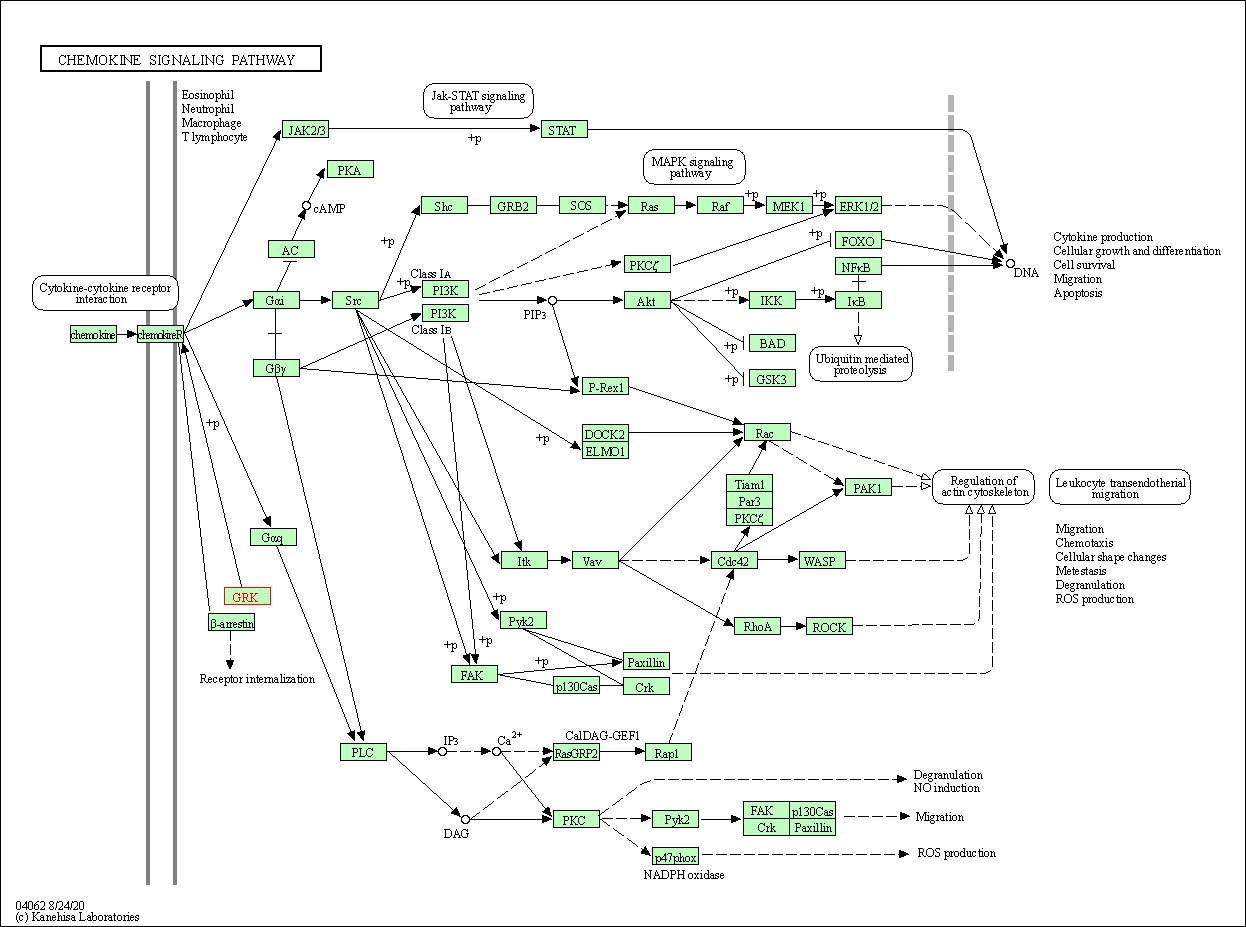
|
| Class: Organismal Systems => Immune system | Pathway Hierarchy | ||
| Endocytosis | hsa04144 | Affiliated Target |
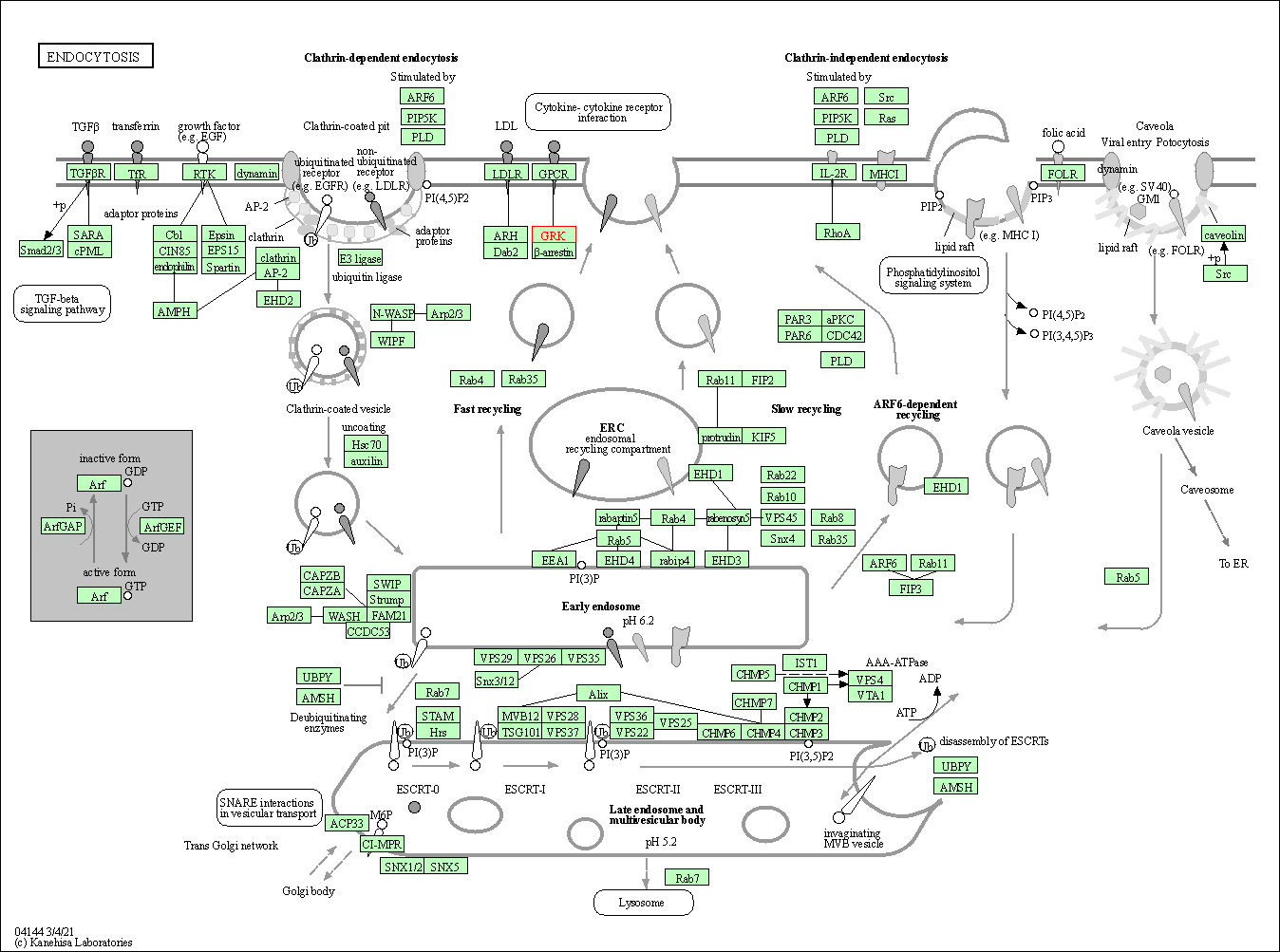
|
| Class: Cellular Processes => Transport and catabolism | Pathway Hierarchy | ||
| Hedgehog signaling pathway | hsa04340 | Affiliated Target |
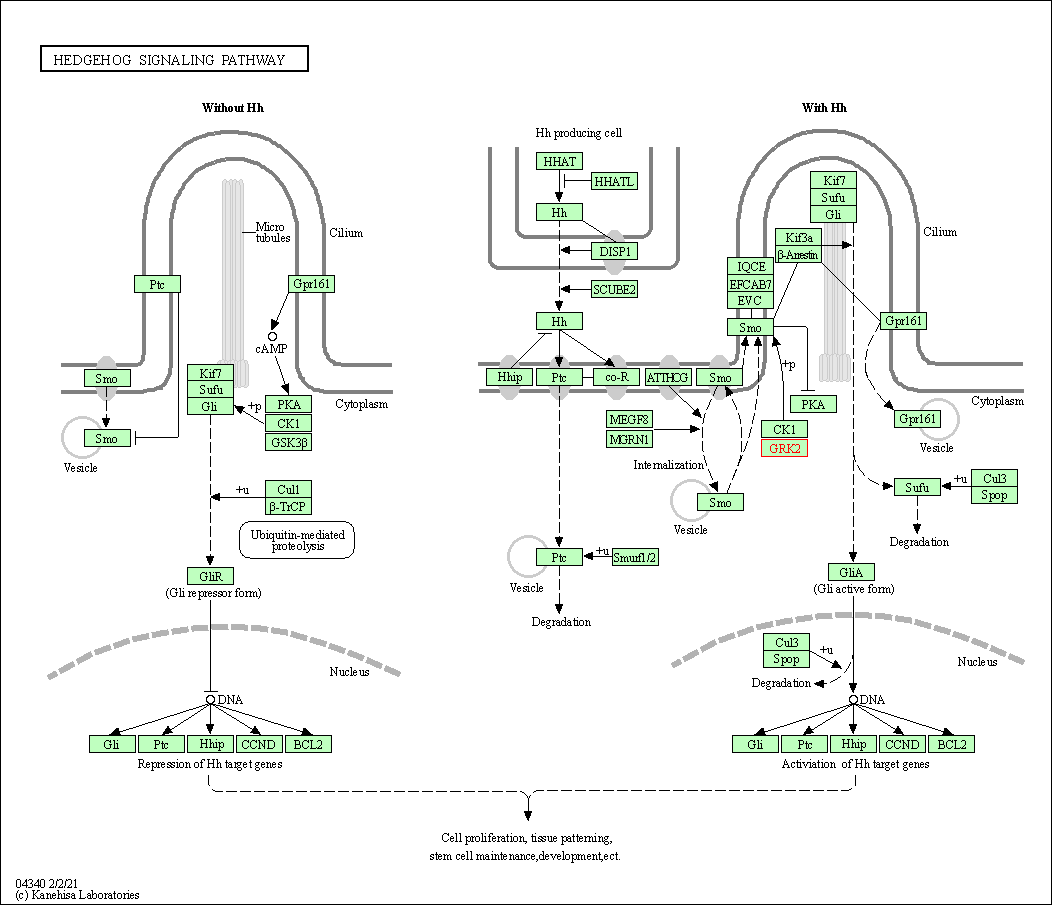
|
| Class: Environmental Information Processing => Signal transduction | Pathway Hierarchy | ||
| Glutamatergic synapse | hsa04724 | Affiliated Target |
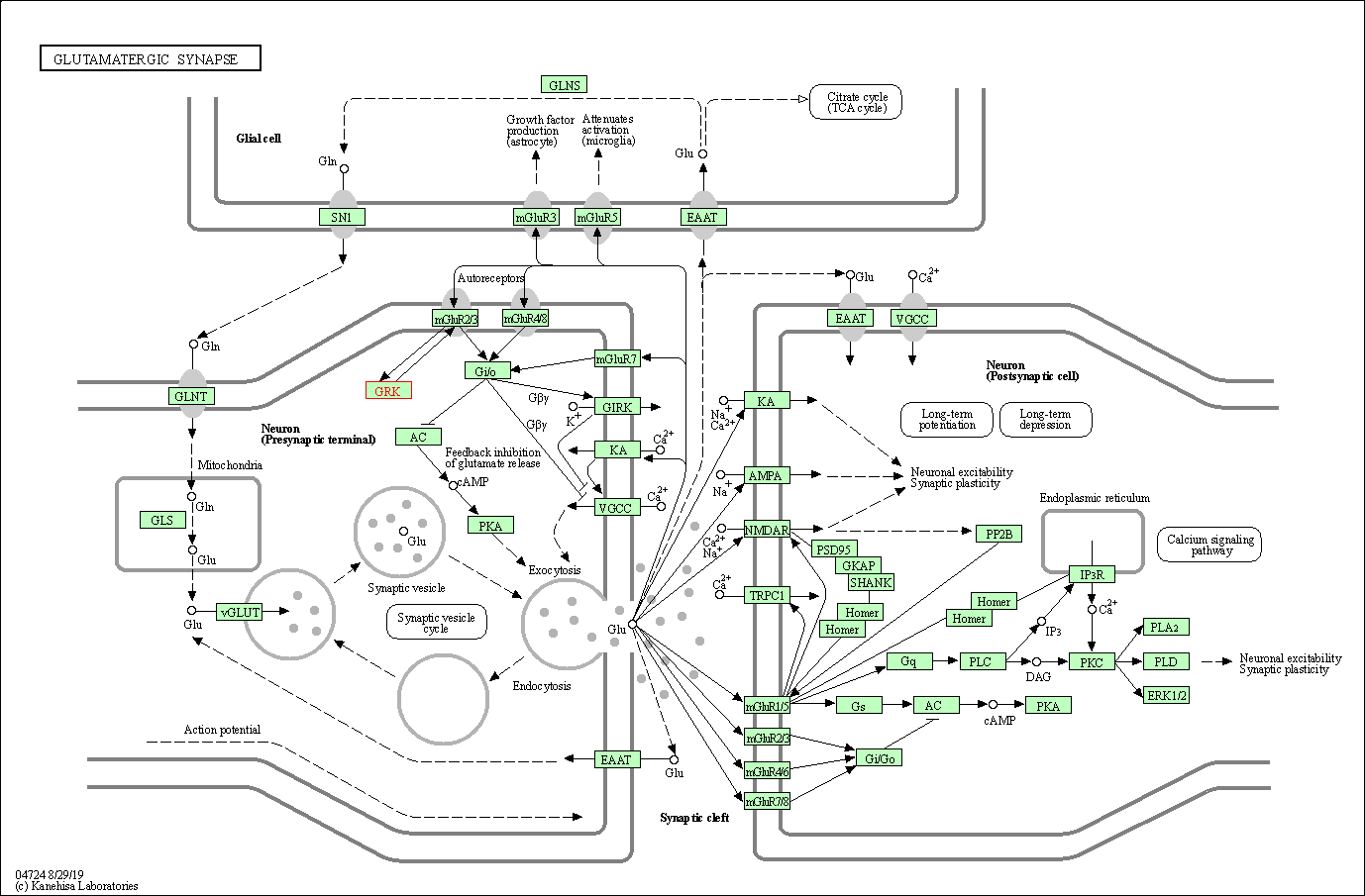
|
| Class: Organismal Systems => Nervous system | Pathway Hierarchy | ||
| Olfactory transduction | hsa04740 | Affiliated Target |
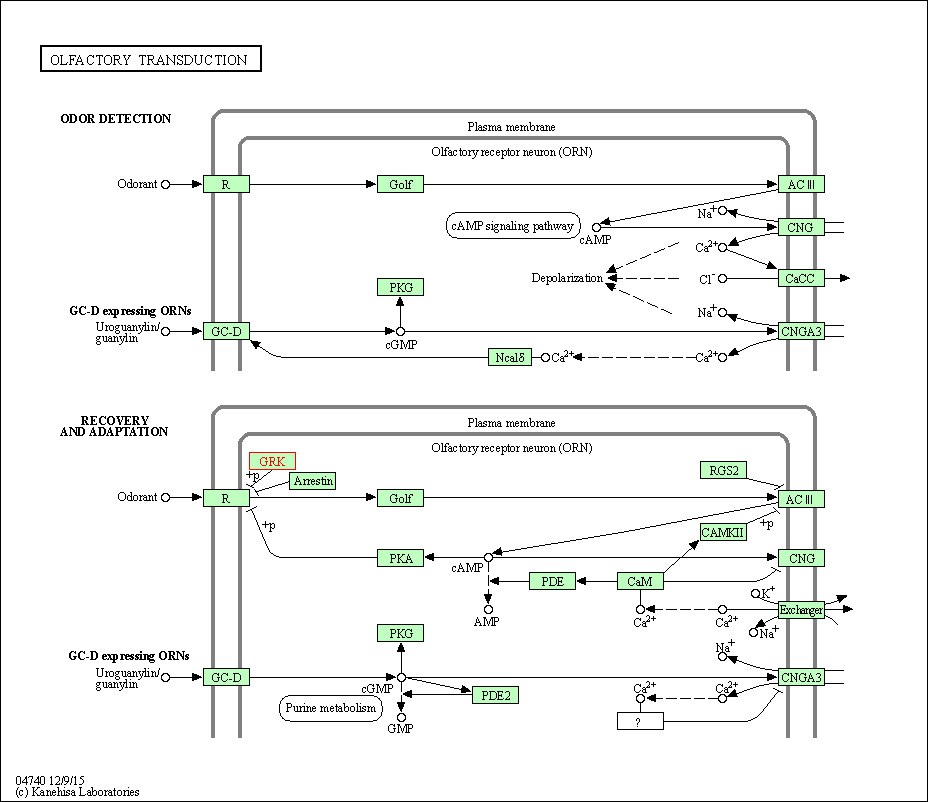
|
| Class: Organismal Systems => Sensory system | Pathway Hierarchy | ||
| Degree | 15 | Degree centrality | 1.61E-03 | Betweenness centrality | 7.70E-04 |
|---|---|---|---|---|---|
| Closeness centrality | 2.24E-01 | Radiality | 1.39E+01 | Clustering coefficient | 1.52E-01 |
| Neighborhood connectivity | 2.20E+01 | Topological coefficient | 9.69E-02 | Eccentricity | 12 |
| Download | Click to Download the Full PPI Network of This Target | ||||
| Chemical Structure based Activity Landscape of Target | Top |
|---|---|
| Drug Property Profile of Target | Top | |
|---|---|---|
| (1) Molecular Weight (mw) based Drug Clustering | (2) Octanol/Water Partition Coefficient (xlogp) based Drug Clustering | |
|
|
||
| (3) Hydrogen Bond Donor Count (hbonddonor) based Drug Clustering | (4) Hydrogen Bond Acceptor Count (hbondacc) based Drug Clustering | |
|
|
||
| (5) Rotatable Bond Count (rotbonds) based Drug Clustering | (6) Topological Polar Surface Area (polararea) based Drug Clustering | |
|
|
||
| "RO5" indicates the cutoff set by lipinski's rule of five; "D123AB" colored in GREEN denotes the no violation of any cutoff in lipinski's rule of five; "D123AB" colored in PURPLE refers to the violation of only one cutoff in lipinski's rule of five; "D123AB" colored in BLACK represents the violation of more than one cutoffs in lipinski's rule of five | ||
| Target Poor or Non Binders | Top | |||||
|---|---|---|---|---|---|---|
| Target Poor or Non Binders | ||||||
| Target Regulators | Top | |||||
|---|---|---|---|---|---|---|
| Target-interacting Proteins | ||||||
| References | Top | |||||
|---|---|---|---|---|---|---|
| REF 1 | Molecular mechanism of selectivity among G protein-coupled receptor kinase 2 inhibitors. Mol Pharmacol. 2011 Aug;80(2):294-303. | |||||
| REF 2 | G protein-coupled receptor kinase 2 inhibitors and methods for use of the same. US10023564. | |||||
| REF 3 | Boron-containing small molecules. US9493490. | |||||
| REF 4 | Gene-mediated inhibition of the b-adrenergic receptor kinase: a new therapeutic strategy for heart failure. Minerva Cardioangiol. 2001 Dec;49(6):389-94. | |||||
| REF 5 | Design and synthesis of novel 3-(benzo[d]oxazol-2-yl)-5-(1-(piperidin-4-yl)-1H-pyrazol-4-yl)pyridin-2-amine derivatives as selective G-protein-coupled receptor kinase-2 and -5 inhibitors. Bioorg Med Chem Lett. 2013 Dec 15;23(24):6711-6. | |||||
| REF 6 | Paroxetine is a direct inhibitor of g protein-coupled receptor kinase 2 and increases myocardial contractility. ACS Chem Biol. 2012 Nov 16;7(11):1830-9. | |||||
| REF 7 | Structure of human G protein-coupled receptor kinase 2 in complex with the kinase inhibitor balanol. J Med Chem. 2010 Feb 25;53(4):1867-70. | |||||
If You Find Any Error in Data or Bug in Web Service, Please Kindly Report It to Dr. Zhou and Dr. Zhang.

